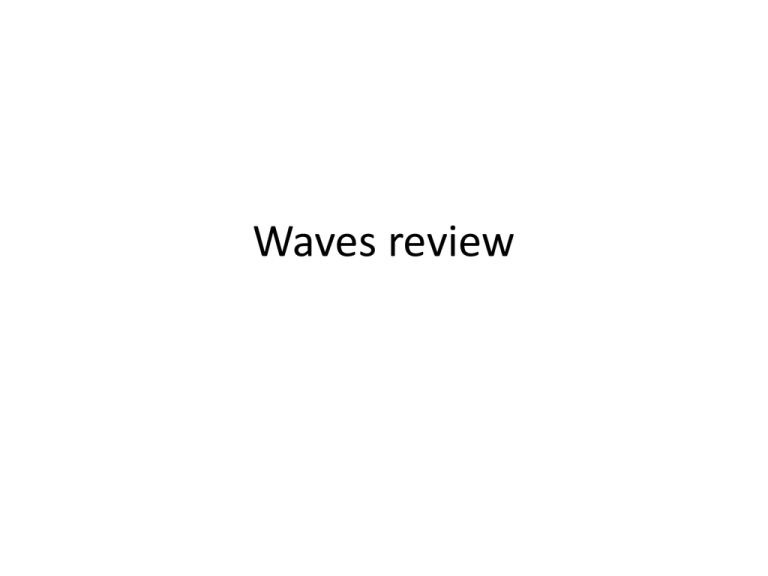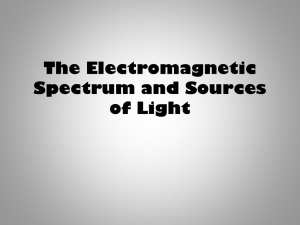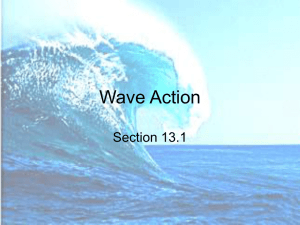Waves review
advertisement

Waves review 1. Identify the cause of waves. Vibrations 2. What do waves carry? Energy Longitudinal Transverse Identify the transverse and longitudinal wave. Which way do particles in a medium move when a wave is passing by? In a circular path Explain the difference between mechanical and electromagentic waves. Mechanical waves need a medium and electromagnetic waves do not need a medium. They can travel through a vacuum. Describe the movement of medium particles in a longitudinal wave. Particles move side to side (parallel to the movement of the wave) Describe the movement of medium particles in a transverse wave. Particles move up and down (at right angles to the movement of the wave) Bw 2 rarefactions Bw 2 compressions Describe a wavelength in a longitudinal wave. The distance between 2 compressions OR 2 rarefactions. Bw 2 crests Bw 2 troughs Describe a wavelength in a transverse wave. The distance between 2 crests OR 2 troughs. C B AA D Identify the parts of this transverse wave. (Click to uncover the answer of each letter) 1. What does a high amplitude indicate about the wave? It is high in energy. 2. What does a high frequency indicate about the wave? It is high in energy. It has a shorter wavelength. 1. Which wave has the highest frequency? A C 2. Which wave has the longest wavelength? A B C Describe the relationship between: 1. Frequency and wavelength As frequency increases, wavelength decreases. 2. Frequency and period As frequency increases, period decreases. 3. Amplitude and energy As amplitude increases, energy increases. 1. Which process is represented in the diagram? refraction 2. Explain what happens to the wave and why. The wave bends because speed the wave changes speed. During refraction, which way does the wave bend when it traveling into a more dense medium? Explain. It bends towards the normal because the wave slows down. During refraction, which way does the wave bend when it traveling into a less dense medium? Explain. It bends away from the normal because the wave sppeds up. 1. What process is taking place in this diagram. Reflection 1. Describe what the light rays are doing. The light waves are bouncing off the surface. What kind of energy do electromagnetic waves carry? Radiant energy 1. Which wave has the highest frequency? gamma rays 2. Which has a shorter wavelength – infrared waves or x-rays? x-rays Which has a higher frequency – microwaves or ultraviolet waves? ultraviolet waves A(n) _________ wave cannot travel through a vacuum. 1) electromagnetic (2) mechanical (3) light (4) transverse In order for a wave to be produced, something must (1)move (2) vibrate (3) spread apart (4) squeeze together Sound waves are _______________ waves. (1) mechanical (2) transverse (3) Electromagnetic (4) longitudinal A transverse wave is a wave in which the (1) motion of the medium & direction of the wave are the same (2) medium is in its liquid phase (3) motion of the medium & direction are at right angles to each other (4) medium is in its solid phase Any substance through which a wave can travel is called a (1) solid (2) vacuum (3) medium (4) liquid A large spring is stretched horizontally between 2 people. One person wiggles the spring up and down at one end. The up-and-down vibration then moves along the spring on to the other person. Which of the following type of wave is created in the spring? 1.pressure wave 2.longitudinal wave 3.transverse wave 4.nonmechanical wave Which of the following statements applies to longitudinal waves? 1.The motion of the medium is random. 2.The motion of the medium is in a circular pattern. 3.The motion of the medium is parallel to the motion of the wave. 4.The motion of the medium is perpendicular to the motion of the wave. The part of a longitudinal waves where particles are farther apart is known as the 1. crest 2. compression 3. trough 4. rarefaction The number of waves passing a point at a given time is known as 1. wavelength 2. frequency 3. period 4. amplitide The time it takes one wavelength to pass a certain point is known as 1. wavelength 2. frequency 3. period 4. amplitude Which of the following best describes the relationship between frequency and wavelength? 1. If the frequency remains constant, wavelength increases. 2. The wavelength decreases and frequency decreases. 3. The frequency increases as wavelength decreases. 4. If the wavelength remains constant, frequency increases. Which of the following electromagnetic waves have the highest frequency? 1. Visible light 2. Ultraviolet light 3. Microwaves 4. Infrared waves Which of the following statements best compares the wavelengths of the region of the electromagnetic spectrum? 1. Microwaves are shorter then X-rays. 2. Infrared rays are longer than gamma waves. 3. Radio waves are shorter than visible light waves. 4. UV waves are longer than visible light waves.






